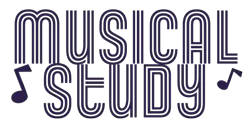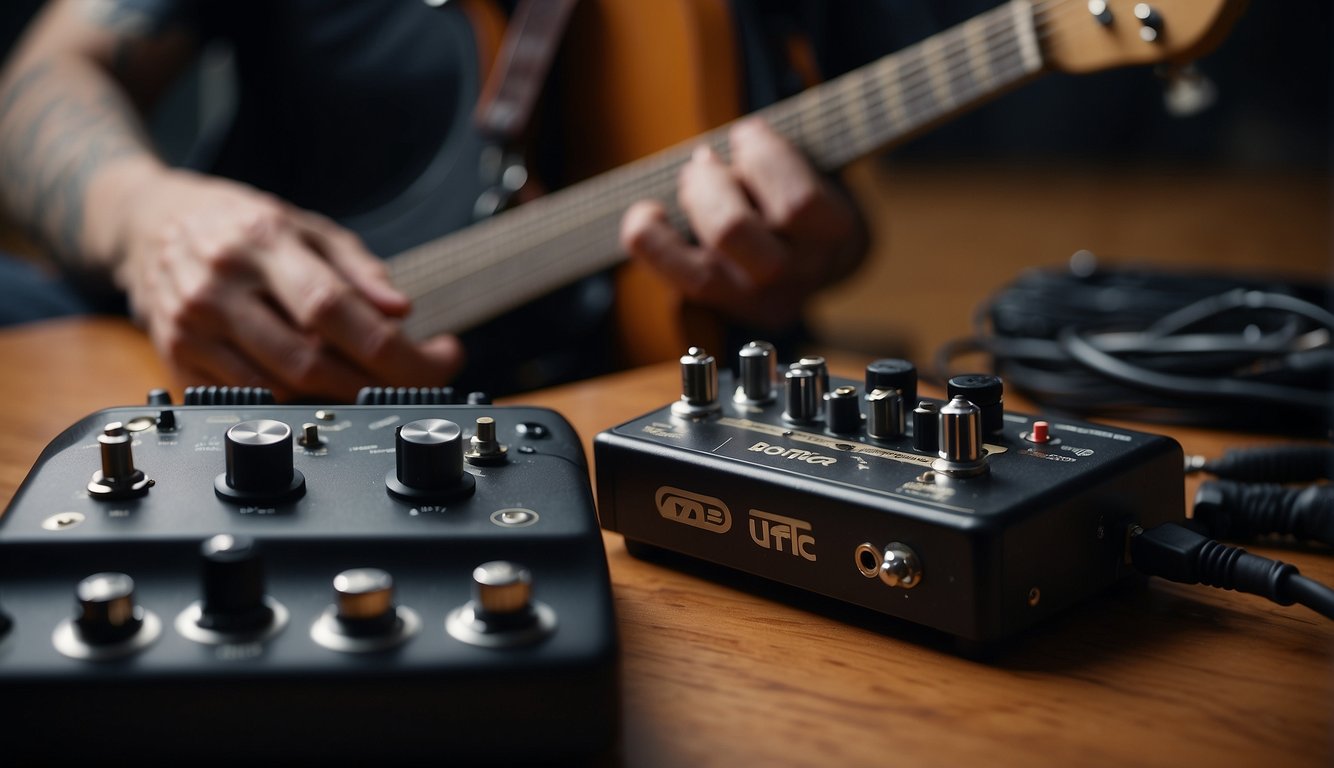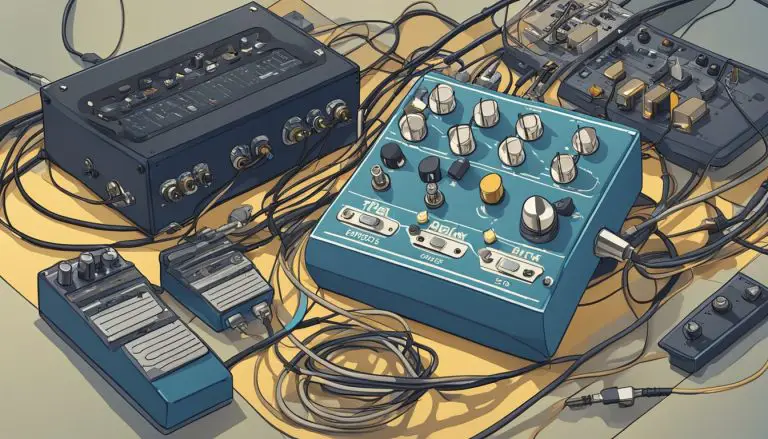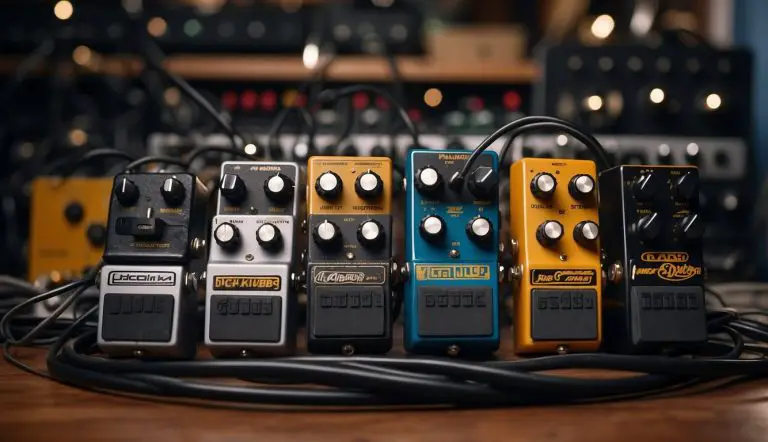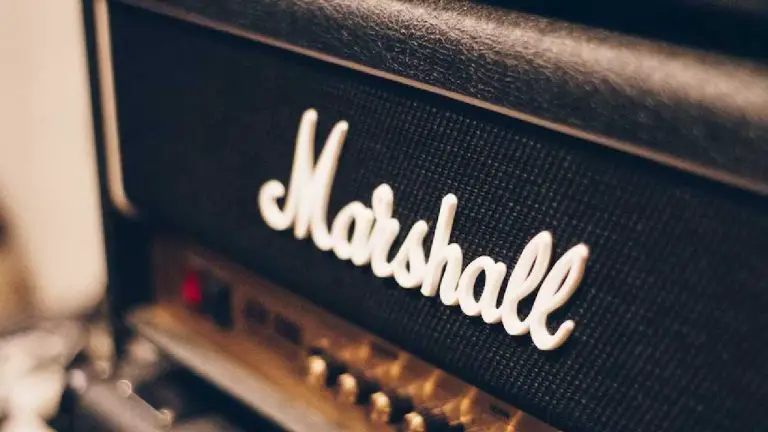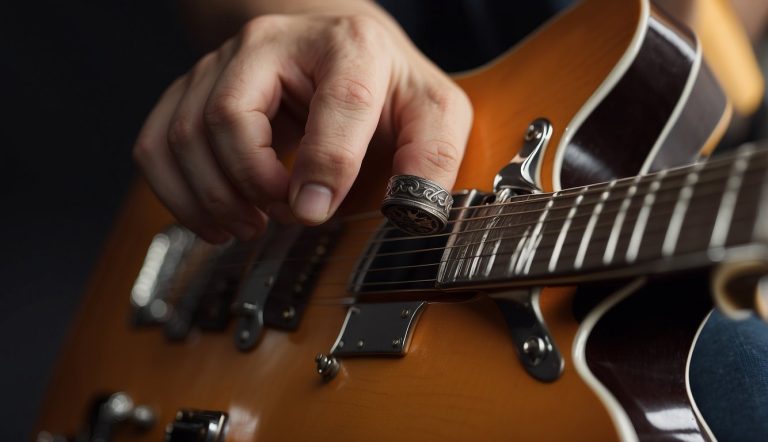Best Distortion Pedals: Essential Picks for Guitarists in 2024
Distortion is a cornerstone of electric guitar tone, shaping the sound in genres ranging from blues and rock to metal.
A distortion pedal is a powerful tool that allows guitarists to push their sound into this gritty territory, manipulating the raw signal to a varying degree of clipped tones.
What makes the best distortion pedal is not only a matter of quality components and construction but also how well it meshes with a player’s individual style and the rest of their gear.
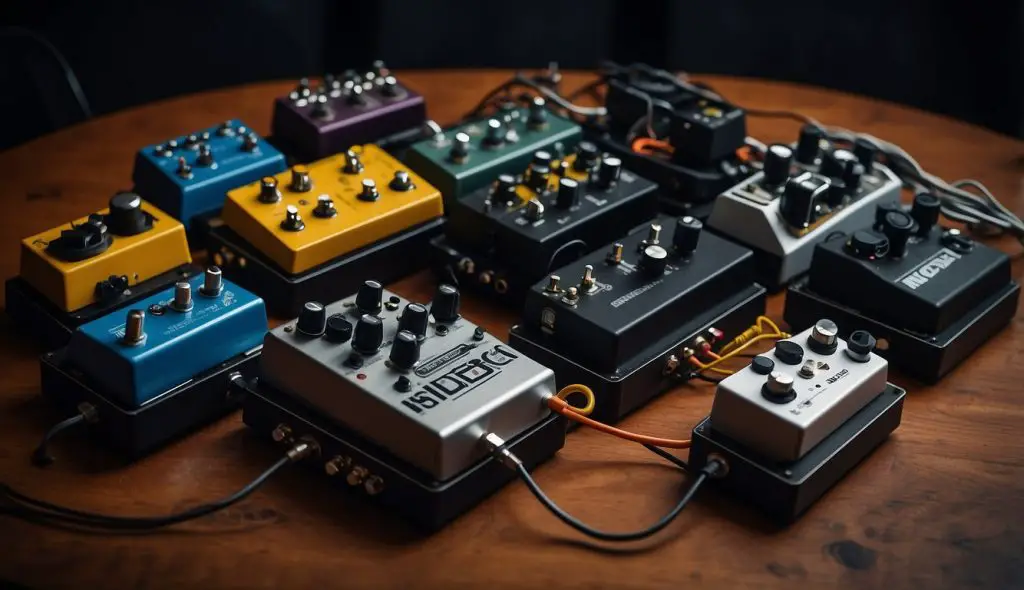
Choosing the right distortion pedal can be an odyssey, given the sheer number of options available on the market.
Each pedal offers a different flavor of distortion, from subtle, smooth overdrive to full-blown, high-gain saturation.
Guitarists often seek pedals that provide a harmonically rich sound without sacrificing clarity.
Some pedals also come with noise gate circuits or multiband distortion capabilities, which can help maintain signal integrity in live settings.
Key Points
- Distortion pedals are vital for achieving a range of toned sounds.
- The suitability of a distortion pedal can vary based on a guitarist’s personal style.
- Features like multiband distortion and noise gates enhance pedal functionality.
Table of Contents
What Are Distortion Pedals?
Distortion pedals are essential tools for guitarists seeking to add color, sustain, and depth to their sound. These devices manipulate the guitar’s audio signal to produce varying degrees of harmonic distortion. I’ll discuss their functionality, types, and the ongoing debate between analog and digital designs.
The Role of Gain and Clipping
Gain acts as the driving force in distortion pedals, amplifying the signal until it begins to clip. Clipping is the distortion of a signal beyond its maximum limit, resulting in a uniquely altered sound. Diodes within the pedal circuitry facilitate this, shaping the character of the distortion.
- Hard Clipping: Diodes clip the signal abruptly, producing a tighter and more aggressive distortion.
- Soft Clipping: Diodes smooth the edges of the clipped signal, generating a warmer and subtler distortion.
Types of Distortion: Fuzz, Overdrive, and High-Gain
Distortion, in my experience, comes in several flavors, each providing a distinct sonic palate:
- Fuzz: Offers a vintage, warm, and rounded tone associated with the ’60s. It’s characterized by extreme clipping and a pronounced sustain.
- Overdrive: Simulates the gentle breakup of a tube amp at high volumes. Overdrive pedals typically feature soft clipping and retain much of the guitar’s original dynamics and texture.
- High-Gain: Designed for heavier music genres that require intense, saturated tones. These pedals push gain to higher levels, resulting in a pronounced and powerful clipping.
Throughout these varieties, elements like eq, tone control, and multi-band processing can refine the distortion effect further.
Analog vs Digital: A Sound Debate
When it comes to distortion pedals, analog and digital models present different advantages.
- Analog Pedals:
- Use actual circuitry to create distortion.
- Often preferred for their warmth and musical harmonic overtones.
- Their tone is frequently described as more “organic.”
- Digital Pedals:
- Employ digital signal processing (DSP) to replicate various distortion sounds.
- Offer greater versatility and precision in shaping the distortion.
Both approaches can achieve excellent results, and my choice depends on the desired tone and practical considerations such as the complexity of setup and pedalboard space.
Our Top Picks – The Best Distortion Pedals
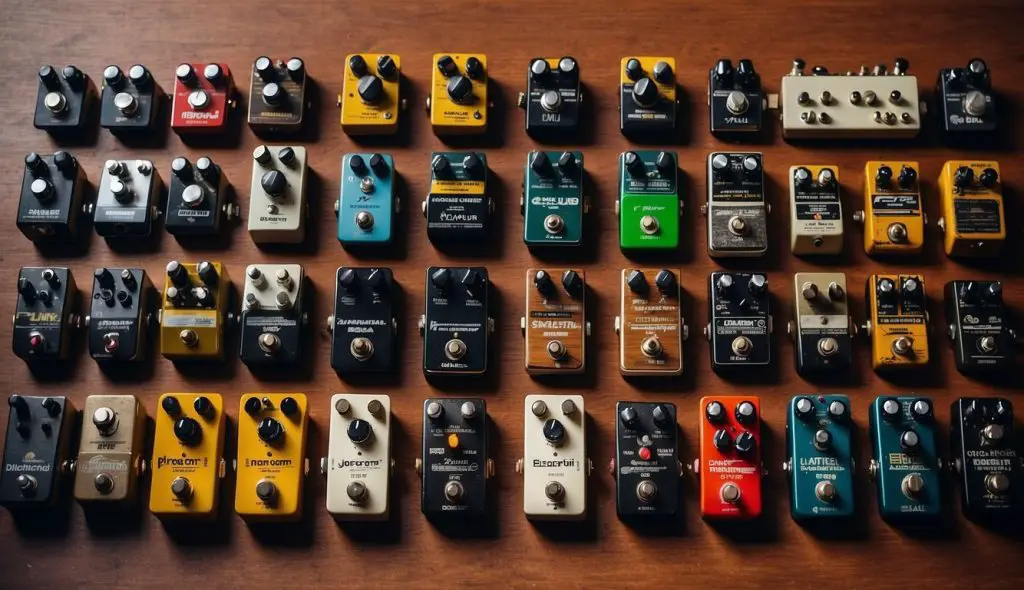
In pursuit of the perfect guitar tone, a distortion pedal is often the cornerstone of my pedalboard. It defines the character of my sound – whether it’s crisp, saturated, or full of crunch. Here are my top picks chosen for their iconic status, capabilities, and tonal qualities.
Boss DS-1: An Affordable Classic
The Boss DS-1 is a stalwart in the world of rock guitar. Its bright orange chassis houses an iconic circuit capable of delivering crisp, driving distortion. What I find remarkable about the DS-1 is its simplicity; a trio of knobs for tone, level, and distortion allow me to dial in just the right amount of saturation.
This pedal excels in its ability to preserve the underlying dynamics of my playing, making it a standout choice for those looking for a classic distortion sound without breaking the bank.
MXR M75 Super Badass: Versatile and Powerful
MXR’s M75 Super Badass distortion is as versatile as it is potent. The pedal provides a wide range of distortions thanks to its highly responsive controls. I appreciate the full spectrum of gain available, from subtle overdrive to full-on distortion.
The inclusion of a 3-band EQ with bass, mid, and treble controls allows me to sculpt my sound in detailed ways, ensuring that this pedal can achieve a unique voice on my pedalboard.
Proco Rat Series: For Refined Crunch
When I’m after a particular type of crunch that’s both refined and raw, I turn to pedals from the Proco Rat series. These pedals have been a mainstay for guitarists spanning many genres due to their distinctive sound profile.
One aspect that I find invaluable is the filter control, which adjusts the pedal’s treble content without diminishing its full-bodied distortion. The Rat pedals also excel in their dynamic response, offering everything from slight edge to thick, harmonically rich distortion that retains the intricacies of my playing style.
Key Features of Distortion Pedals
When assessing distortion pedals, I focus on the core components that shape their performance and integration with my rig. These include the EQ options for tone shaping, the type of bypass they employ, and how they fit within a pedalboard setup.
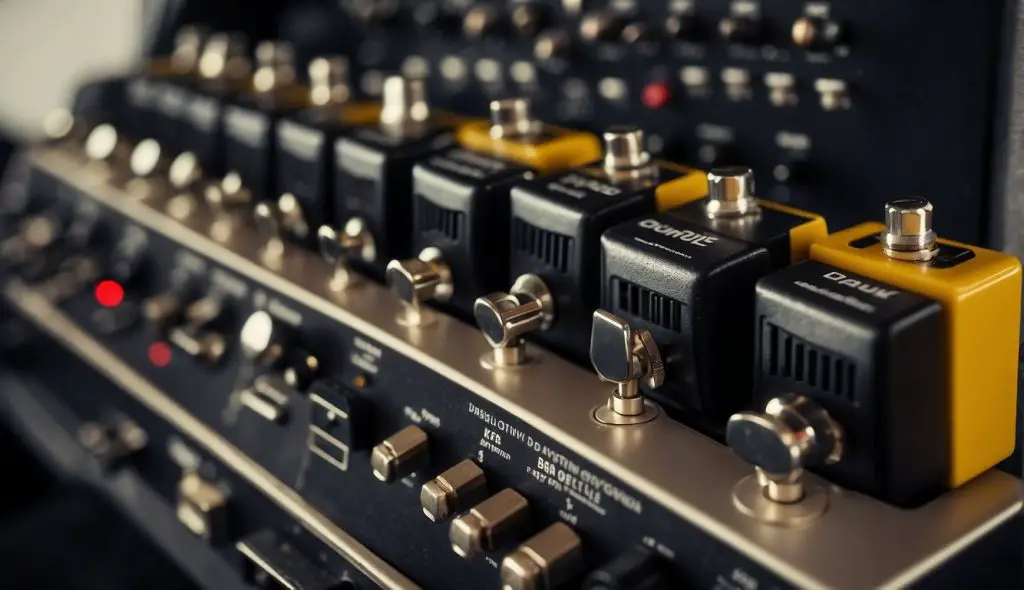
EQ and Tone Shaping Options
Every distortion pedal I encounter has its unique way of altering the guitar signal’s EQ profile. The tone knob is a standard feature that allows me to adjust the balance between low and high frequencies, tailoring the sound to suit my taste.
More advanced models may include additional EQ controls, like a filter knob, providing precise sculpting of the midrange, or multi-band EQ, which enables me to manipulate separate frequencies independently.
True Bypass vs Buffered Bypass
The bypass method is crucial—it affects the signal flow when the pedal is disengaged.
Pedals with true bypass wiring remove themselves entirely from the signal chain, preserving the original tone of my instrument. On the other hand, buffered bypass pedals maintain a connection through a buffer circuit, which can prevent high-frequency loss over long cable runs.
This is particularly beneficial when I integrate multiple pedals into my pedalboard.
Integration with Pedalboards
How a distortion pedal interacts with other pedals is significant to my setup. The pedal’s bypass status can influence the signal integrity when placed in a chain.
Furthermore, the inclusion of an EQ section within the distortion pedal can reduce the need for additional EQ units on my pedalboard, saving space.
Distortion pedals with flexible connectivity options, like stereo inputs or outputs, offer me versatile incorporation with my existing gear.
Choosing the Right Pedal for Your Style
When I select a distortion pedal, I consider the specific style of music I’m aiming to play. The pedal must match the gain stage requirements and have the voicing to support the stylistic nuances.
Pedals for Metal and Hard Rock
For Metal and Hard Rock, a pedal that delivers heavy distortion with precision is key. The best distortion pedals for these genres often have multiple gain stages and allow for tight low-end response, as well as mid-range scooping capabilities for aggressive palm-muted chugging and intricate solos.
- Gain Stage: The pedal should have a high gain stage to deliver the intense distortion necessary for metal.
- Voicing: Look for pedals that offer precise voicing control to shape the tone for heavy riffs and screaming leads.
Examples include models that provide intense distortion without muddying complex chords, ensuring clarity even at extreme settings.
Blues and Classic Rock: Subtler Distortions
For Blues and Classic Rock, guitarists generally prefer pedals that offer subtler distortion, allowing the character of the guitar to shine through. The best choices are those that provide a warm overdrive, reminiscent of tube amps, that can go from a gentle growl to a biting snarl when needed.
- Preset Options: Some pedals come with presets optimised for blues, facilitating a classic, gritty tone.
- Dynamic Response: The pedal should respond well to your playing dynamics, cleaning up as you play softly and biting harder when you dig in.
I recommend looking for pedals that have the ability to blend the clean signal with the overdriven signal to maintain the guitar’s natural timbre while adding just enough edge.
Advanced Usage and Tips
In my exploration of distortion pedals, I’ve discovered that mastery comes from understanding the subtleties of signal chain placement and noise management. Let’s dive into how to enhance your tonal palette and ensure a clean performance.
Combining Pedals for Unique Tones
I find that stacking multiple pedals, such as an overdrive before a fuzz pedal, can create rich, complex tones. It’s about using the gain stages effectively:
- Clean Boost: Before distortion, it can increase volume without altering tone significantly.
- Overdrive Pedal: Placing it before a fuzz pedal often results in a warm, harmonically rich distortion.
- Fuzz Pedal: I place this after overdrive to capitalize on its raw, aggressive character.
- Compression: A compressor before distortion helps even out the dynamic range, enhancing sustain without additional noise.
Experimenting with the sequence of these pedals allows me to tailor my sound for different stages and settings, enhancing the presence of my guitar.
Maintaining Signal Quality and Noise Control
To maintain top-notch signal quality while controlling noise, I employ a few key pieces of gear and techniques:
- Noise Gate: I place this either at the beginning of the chain to catch noise from the guitar or at the end to deal with accumulated noise.
- Signal Buffers: By strategically placing them in my chain, I mitigate tone loss, especially if I have a long chain or use long cables on stage.
- LED Indicators: These are invaluable for me on stage to quickly see which pedals are engaged and to troubleshoot any issues in a live setting.
Maintaining signal quality is pivotal — it ensures that the nuances of my playing and the distinctive characteristics of my effects remain intact.
Pedals with Notable Users
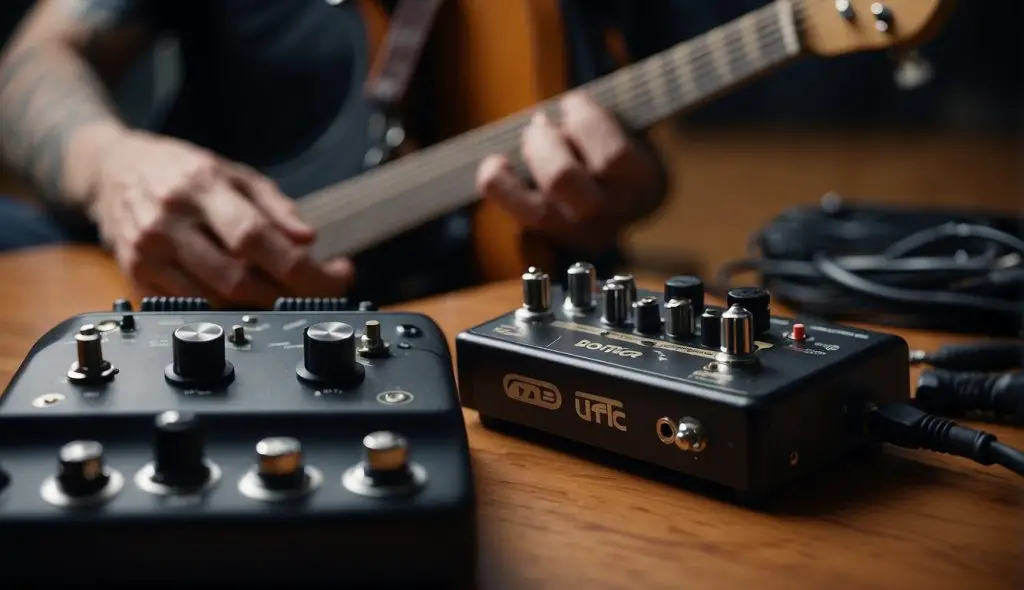
In my experience, the choice of distortion pedals among iconic artists has shaped the landscape of music, especially within genres like rock and metal. These players have often gravitated towards certain models that have become synonymous with their sound.
Iconic Artists and Their Choices
Kurt Cobain
- Pedal: Boss DS-1 Distortion
- Usage: A staple on Cobain’s pedalboard, the DS-1 is famed for its crunchy distortion that was a cornerstone of the grunge movement.
Kirk Hammett
- Pedal: ProCo Rat 2
- Usage: As the lead guitarist of Metallica, Hammett’s use of the Rat 2 contributed to his cutting solos and helped define the aggressive guitar tone Metallica is known for.
Metalheads
- Pedal: EarthQuaker Devices Acapulco Gold
- Usage: This pedal is a modern staple for guitarists seeking a powerful, tube-amp-like distortion reminiscent of a vintage Sunn Model T, popular in heavier music genres.
Regarding pedal types:
- Fuzz Pedal: Adored by enthusiasts of warmer, vintage-sounding distortion.
- Overdrive Pedal: Often used to add warmth and slight breakup, mimicking overdriven tube amps.
Both pedal types contribute uniquely to a guitar’s tone, and many players combine them to create complex textures. The ProCo Rat 2, for instance, resides somewhere between a distortion, fuzz, and overdrive, providing versatility preferred by many guitarists, including Hammett.
Frequently Asked Questions
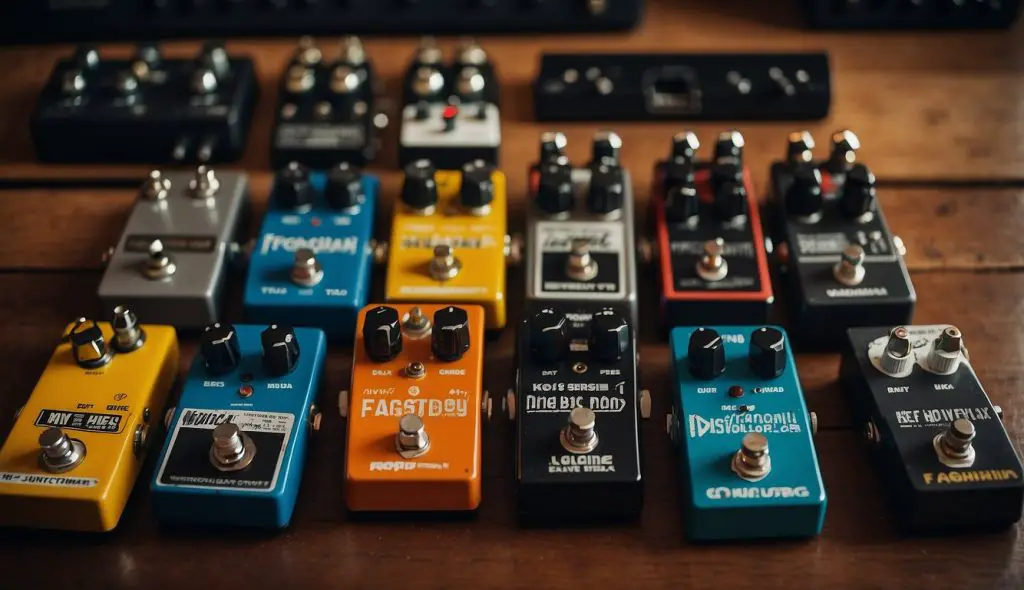
In this section, I’ll address common inquiries regarding distortion pedals, focusing on varied genres, price points, and specific artist sounds for those seeking to refine their tone.
What are some top-rated distortion pedals for metal?
For metal enthusiasts, pedals like the Boss MT-2 Metal Zone and the Electro-Harmonix Metal Muff are highly regarded for their aggressive distortion and extensive tone-shaping capabilities.
How can one replicate the distinct distortion used by Nirvana with modern pedals?
Kurt Cobain of Nirvana was known to use the Electro-Harmonix Big Muff Pi. To achieve a similar grunge sound, the Big Muff Pi is still a relevant and popular choice among guitarists today.
Which distortion pedals do professionals like Metallica use for their signature sound?
Metallica’s guitarists have famously used the Mesa/Boogie amplifiers in conjunction with various pedals. However, for a pedal-focused approach, the BOSS Metal Zone MT-2 can mimic their high-gain sound.
What options are there for an overdrive distortion pedal with versatile applications?
A versatile overdrive distortion pedal is the Boss SD-1 Super Overdrive, which can seamlessly transition from soft overdrive to hard distortion, making it highly adaptable for various musical styles.
Can you recommend budget-friendly distortion pedals that don’t compromise on quality?
The Pro Co RAT2 and the TC Electronic Dark Matter provide excellent distortion tones without a hefty price tag. They are known for their quality build and versatile sound.
Which distortion pedals are favored for achieving a classic rock tone?
The Ibanez Tube Screamer and the Fulltone OCD are classics that offer warm, tube-like drive suitable for classic rock. Players often choose them for their responsive and dynamic gain range.
